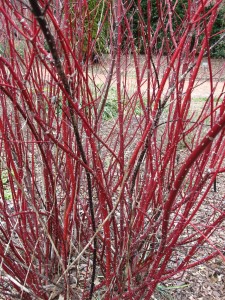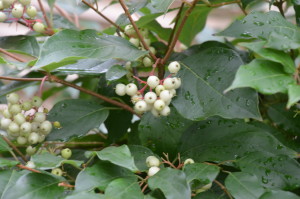Red osier dogwood (Cornus sericea) is a medium-sized, deciduous shrub native to much of the Northern and Western United States (USDA hardiness zones 2-7). Without question these shrubs standout in winter by their colorful stems (see pruning recommendations below). Cut branches are an added plus for indoor arrangements. The yellow-twig form (C. sericea ‘Flaviramea’) is also available.
Leaves are oblong-lanceolate (up to 5 inches long), oppositely arranged with 5-7 pairs of lateral veins, and entire margins. Species may grow up to 10 feet tall and spread voraciously by underground stolons to form large clumps. One landscape idea is to mix red and yellow–twig dogwoods together for a winter color blast. Osier dogwoods grow well in very large containers, but quickly outgrow their pot space in 2-3 years.
These stoloniferous dogwoods bloom in mid-spring (in Tennessee). The terminal creamy white (cyme) flowers measure 1.5 to 2.0 inches across and white berries follow in late summer.
Plant shrubs in full sun (in northern areas) and in partial shade (in zone 7) and average soil. Fertilize in early spring before buds break and irrigate during long dry summer spells. Shrubs establish quickly and are very drought tolerant after one year. Many cultivars are available, and are highly variable in leaf and stem color. This shrub dogwood may be confused with C. amomum which has a similar red bark, but C. amomum has blue fruits and brown pith.
Arctic Fire® is a non-suckering compact form with dark red winter stems. It grows 4-5 feet tall and 4-5 feet wide. It puts on a spectacular show in the wintert. Most varieties of stoloniferous dogwoods grow 8 to 10 feet, making Arctic Fire a great breakthrough for smaller gardens or residential landscapes.
Stoloniferous dogwoods are disease and insect resistant and deer generally overlook them. They make great landscape additions; utilize them in perennial or shrub borders, masses and groupings, container gardens and winter gardens.



 Posted in
Posted in 
